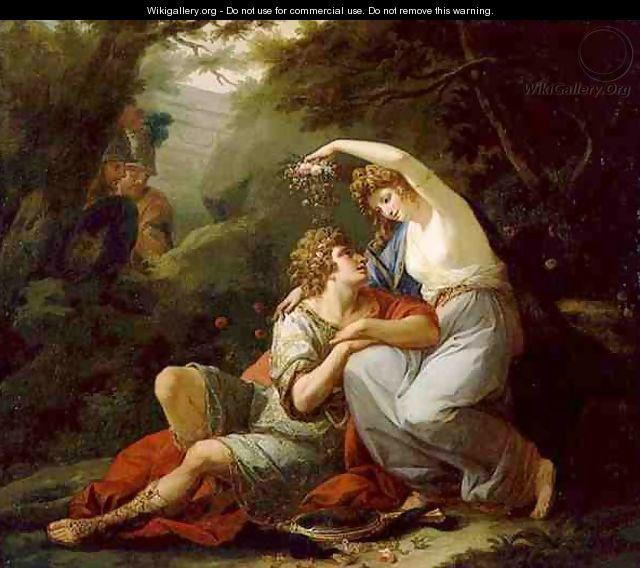Angelica Kauffmann Swiss (October 30, 1741 - November 5, 1807
Angelica Kauffmann Biography Maria Anna Angelica Kauffmann (October 30, 1741 - November 5, 1807) was a Swiss painter. She was born at Chur in Graubünden. Her father, Johann Josef Kauffmann, was a poor man and mediocre painter, but apparently very successful in teaching his precocious daughter. She rapidly acquired several languages, read incessantly, and showed marked talents as a musician. Her greatest progress, however, was in painting; and in her twelfth year she had become a notability, with bishops and nobles for her sitters. In 1754 her father took her to Milan. Later visits to Italy of long duration followed: in 1763 she visited Rome, returning again in 1764. From Rome she passed to Bologna and Venice, being everywhere feted and caressed, as much for her talents as for her personal charms. Writing from Rome in August 1764 to his friend Franke, Winckelmann refers to her exceptional popularity. She was then painting his picture, a half-length, of which she also made an etching. She spoke Italian as well as German, he says; and she also expressed herself with facility in French and English, one result of the last-named accomplishment being that she painted all the English visitors to the Eternal City. "She may be styled beautiful," he adds, "and in singing may vie with our best virtuosi." While at Venice, she was induced by Lady Wentworth, the wife of the English ambassador to accompany her to London, where she appeared in 1766. One of her first works was a portrait of David Garrick, exhibited in the year of her arrival at "Mr Moreing's great room in Maiden Lane." The rank of Lady Wentworth opened society to her, and she was everywhere well received, the royal family especially showing her great favour. Her firmest friend, however, was Sir Joshua Reynolds. In his pocket-book, her name as "Miss Angelica" or "Miss Angel" appears frequently, and in 1766 he painted her, a compliment which she returned by her "Portrait of Sir Joshua Reynolds". Another instance of her intimacy with Reynolds is to be found in her variation of Guercino's "Et in Arcadia ego", a subject which Reynolds repeated a few years later in his portrait of Mrs Bouverie and Mrs Crewe. When, about November 1767, she was entrapped into a clandestine marriage with an adventurer who passed for a Swedish count (the Count de Horn), Reynolds befriended her, and it was doubtless owing to his good offices that her name is found among the signatories to the famous petition to the king for the establishment of the Royal Academy. In its first catalogue of 1769 she appears with "R.A." after her name (an honour she shared with one other lady, Mary Moser); and she contributed the "Interview of Hector and Andromache", and three other classical compositions. Her friendship with Reynolds was criticised in 1775 by fellow Academician Nathaniel Hone in his satirical picture "The Conjurer". This attacked the fashion for Italian Renaissance art, ridiculed Reynolds, and included a nude caricature of Kauffmann, later painted out by Hone. The work was rejected by the Royal Academy. From 1769 until 1782, she was an annual exhibitor, sending sometimes as many as seven pictures, generally classic or allegorical subjects. One of the most notable was "Leonardo expiring in the Arms of Francis the First" 1778. In 1773 she was appointed by the Academy with others to decorate St Paul's Cathedral, and it was she who, with Biagio Rebecca, painted the Academy's old lecture room at Somerset House. It is probable that her popularity declined a little in consequence of her unfortunate marriage; but in 1781, after her first husband's death (she had been long separated from him), she married Antonio Zucchi (1728-1795), a Venetian artist then resident in England. Shortly afterwards she retired to Rome, where she lived for 25 years with much of her old prestige. In 1782 she lost her father; and in 1795 (the year in which she painted the picture of Lady Hamilton) her husband. She continued at intervals to contribute to the Academy, her last exhibit being in 1797. After this she produced little, and in 1807 she died in Rome, being honoured by a splendid funeral under the direction of Canova. The entire Academy of St Luke, with numerous ecclesiastics and virtuosi, followed her to her tomb in S. Andrea delle Fratte, and, as at the burial of Raphael, two of her best pictures were carried in procession. The works of Angelica Kauffmann have not retained their reputation. She had a certain gift of grace, and considerable skill in composition. But her figures lack variety and expression; and her men are masculine women. Her colouring, however, is fairly enough defined by Gustav Friedrich Waagen's term "cheerful". As of 1911, rooms decorated by her brush were still to be seen in various quarters. At Hampton Court was a portrait of the duchess of Brunswick; in the National Portrait Gallery, a self-portrait. There were other pictures by her at Paris, at Dresden, in the Hermitage at St Petersburg, and in the Alte Pinakothek at Munich. The Munich example was another portrait of herself; and there was a third in the Uffizi at Florence. A few of her works in private collections were exhibited among the Old Masters at Burlington House. But she is perhaps best known by the numerous engravings from her designs by Schiavonetti, Bartolozzi and others. Those by Bartolozzi especially still found considerable favour with collectors. Her life was written in 1810 by Giovanni de Rossi. It has also been used as the basis of a romance by Leon de Wailly (1838) and it prompted the charming novel contributed by Mrs Richmond Ritchie to the Cornhill Magazine in 1875 entitled "Miss Angel".

















































































































ليست هناك تعليقات:
إرسال تعليق